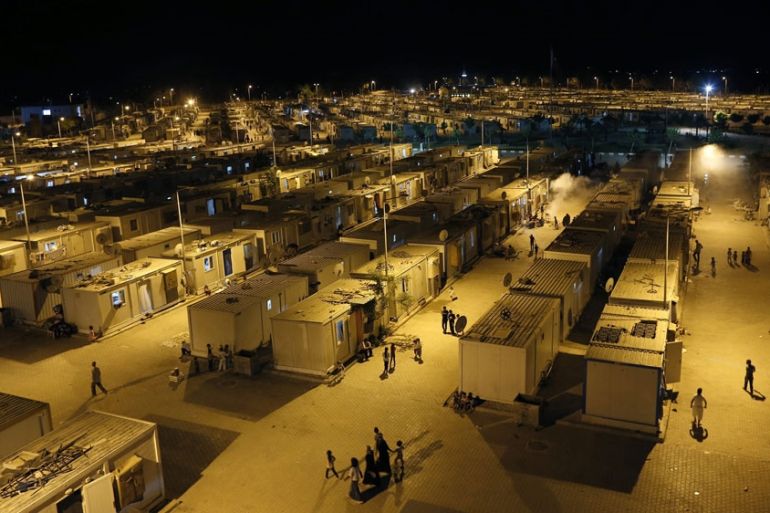The EU can learn from Turkey’s refugee experience
It’s time to stop passing the buck and launch an efficient effort for refugees based on the best modern innovations.

The fist-sized rolls of dough are plopped on to a conveyor belt by a machine. The belt carries them through various stages as they are coated with oil, travel up and around into a giant metal toaster and emerge on the other side transformed into ballooning, hot pieces of flat bread.
“Take one”, says Abdulsalam Sharif the coordinator for the local branch of Insani Yardim Vakfi, or Humanitarian Relief Fund (IHH). The piping hot bread is buttery in the mouth; it is a welcome nourishment after a long day visiting refugees on the Turkish-Syrian border near the town of Kilis in southern Turkey.
Keep reading
list of 4 itemsPhotos: Africa’s cholera crisis is worse than ever
‘We love Taiwan’: Domestic workers hope for more from new President Lai
Amid global polarisation, the pandemic agreement encourages cooperation
The IHH operation in Kilis, which has recently opened a 2,800 sq metre warehouse for storing dry foodstuffs, clothing, and essentials such as toiletries, as well as producing meals, is one of several innovative projects aiding Syrian refugees.
What makes the IHH stand out is its efficiency and modern design: With 365 men, almost all Syrians, volunteering and employed, they are providing 25,000 hot meals a day and 100,000 pieces of bread to be shipped across the border to Syria.
There are estimated to be some 100,000 refugees in Syria across the border from Kilis, and another 110,000 living in Kilis itself and near the border. These are just one portion of the 2.5 million Syrian refugees estimated to have crossed into Turkey from Syria.
More than a million have decamped for Europe, creating the scenes of refugee crises that brought European Union member states and Turkey to yet another summit meeting on February 17 in Brussels.
The discussions in the EU come amid threats in France to demolish the “Jungle” in Calais, home to 1,000 refugees, by Tuesday night. On February 21 it was reported that people cheered an arson attack in Bautzen in Germany on a building converted to house asylum-seekers. According to officials, there have been more than 1,000 attacks on shelters and other services associated with refugees in Germany since last year.
The scenes of chaos on the Greek islands, the violence, human trafficking and abuses women refugees have been victims of; the masses of people unchecked and herded across borders by border police in Greece, Macedonia, Serbia and elsewhere, without a semblance of imposing order or providing dignity, is symbolic of a continent-wide breakdown.
Why has this crisis been so difficult for the EU to handle? With a population of 500 million and a gross domestic product of $18 trillion, why is the EU so much less capable of dealing with a refugee crisis than Turkey with a GDP of $798bn and a population of 77 million?
Explanations range from a supposed historical lack of expertise in dealing with immigrants, to the unwieldy nature of the EU structures and open borders of the Schengen agreement, along with refugee and asylum seeker statuses that seem to encourage poorer countries to push the burden on to wealthier ones.
The fact is that the EU member states have a long history of dealing with refugees. They were more than capable of housing and settling the tens of millions displaced after World War II and the Holocaust. Austria was capable of processing 200,000 Hungarian refugees in 1956.
Yet, in 2016 it has advocated taking only 80 people a day. How is it possible the country that had barely recovered from the ravages of the World War II was more able to handle a massive crisis than one of the most technologically advanced countries of the EU today?
The scenes of chaos on the Greek islands, the violence, human trafficking and abuses women refugees have been victims of; the masses of people unchecked and herded across borders by border police in Greece, Macedonia, Serbia and elsewhere, without a semblance of imposing order or providing dignity, is symbolic of a continent-wide breakdown.
In Turkey the Afet ve Acil Durum Yonetimi Baskanligi (Disaster and Emergency Management Presidency, AFAD), an organisation established in 2009 to deal with natural disasters, has pioneered building refugee camps across Turkey of which there are now 23. It is building new two-storey, container-type housing for the people.
OPINION: Smarter assistance for Syrian refugees
Turkey struggles with some of the same issues facing Europe, namely a population of refugees that may be using the country to pass through to other places or may end up putting down permanent roots.
It also has locals who resent them and a government that does not provide them with equal rights. But, the level of order it has imposed, and the attempt to teach children Turkish and provide job training should be studied and provide a model.
![A Syrian refugee from Idlib works in sowing at the AFAD Oncupinar refugee camp at the Bab al-Salam border crossing near Kilis, Turkey [Seth J Frantzman/Al Jazeera]](/wp-content/uploads/2016/02/7dbe8a3a20cc4e4d8b0345ca1396eda6_18.jpeg)
I have travelled the refugee route from Greece to Austria and it is one band-aid fix and tragedy after another. Europe has had refugees arriving in large numbers by boat from North Africa for two decades now, and addressed it piecemeal and failed.
It’s time to stop passing the buck and launch a serious and efficient effort for refugees based on the best modern innovations.
Seth J Frantzman is a Jerusalem-based commentator on Middle East politics and has lectured in American studies at Al-Quds University.
The views expressed in this article are the author’s own and do not necessarily reflect Al Jazeera’s editorial policy.
